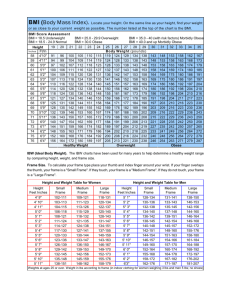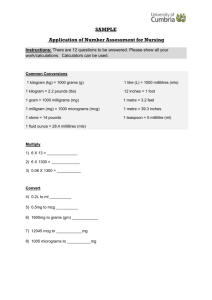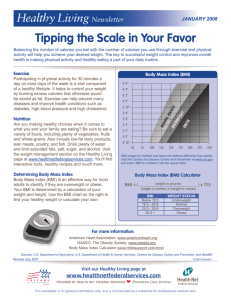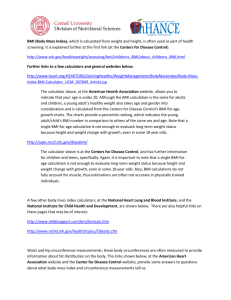BMI lesson plan Carol and Lucille
advertisement
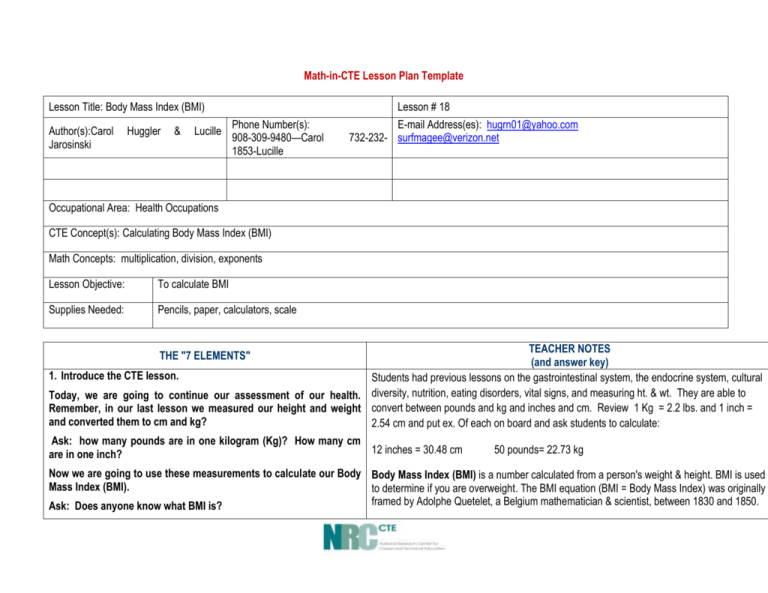
Math-in-CTE Lesson Plan Template Lesson Title: Body Mass Index (BMI) Author(s):Carol Jarosinski Huggler & Lucille Lesson # 18 Phone Number(s): 908-309-9480—Carol 1853-Lucille E-mail Address(es): hugrn01@yahoo.com 732-232- surfmagee@verizon.net Occupational Area: Health Occupations CTE Concept(s): Calculating Body Mass Index (BMI) Math Concepts: multiplication, division, exponents Lesson Objective: To calculate BMI Supplies Needed: Pencils, paper, calculators, scale TEACHER NOTES (and answer key) 1. Introduce the CTE lesson. Students had previous lessons on the gastrointestinal system, the endocrine system, cultural Today, we are going to continue our assessment of our health. diversity, nutrition, eating disorders, vital signs, and measuring ht. & wt. They are able to Remember, in our last lesson we measured our height and weight convert between pounds and kg and inches and cm. Review 1 Kg = 2.2 lbs. and 1 inch = and converted them to cm and kg? 2.54 cm and put ex. Of each on board and ask students to calculate: THE "7 ELEMENTS" Ask: how many pounds are in one kilogram (Kg)? How many cm 12 inches = 30.48 cm are in one inch? 50 pounds= 22.73 kg Now we are going to use these measurements to calculate our Body Body Mass Index (BMI) is a number calculated from a person's weight & height. BMI is used Mass Index (BMI). to determine if you are overweight. The BMI equation (BMI = Body Mass Index) was originally framed by Adolphe Quetelet, a Belgium mathematician & scientist, between 1830 and 1850. Ask: Does anyone know what BMI is? Adolphe was the first person to think of relating wt. to ht. in a statistical, expressible manner. In the 1950's and 1960's we were getting noticeably fatter, so Adolphe's nineteenth century BMI equation was dusted off and used to express relative thinness or fatness across a large population. Whether working with average weight, over-weight, or underweight people the BMI calculation provides a snapshot of relative weight. Calculating BMI is one of the best methods for population assessment of overweight and obesity. Because calculation requires only ht & wt, it is inexpensive and easy to use for clinicians & for the general public. The use of BMI allows people to compare their own wt. status to that of the general population. Ask: Define overweight and obese. Overweight is defined as having more body fat than is optimally healthy (BMI 25-29.9). Obese is defined as a condition in which excess body fat has accumulated to the extent that it may have an adverse effect on health leading to reduced life expectancy and health problems (BMI of ≥ 30). Interpretation of BMI for adults For adults 20 years old and older, BMI is interpreted using standard weight status categories that are the same for all ages and for both men and women. For children and teens, on the other hand, the interpretation of BMI is both age- and sex-specific. The standard wt. status categories associated with BMI ranges for adults are shown in the following table. BMI Weight Status Below 18.5 Underweight 18.5 – 24.9 Normal 25.0 – 29.9 Overweight 30.0 and Above Obese Ask: Why is BMI calculated differently for children and teens? Although the BMI number is calculated the same way for children and adults, the criteria used to interpret the meaning of the BMI number for children and teens are different from those used for adults. For children and teens, BMI age- and sex-specific percentiles are used for two reasons: The amount of body fat changes with age. The amount of body fat differs between girls and boys. The CDC BMI-for-age growth charts take into account these differences and allow translation of a BMI number into a percentile for a child's sex and age. How is BMI calculated and interpreted for children and teens? Ask: How is BMI calculated and interpreted for children and teens? Calculating and interpreting BMI using the BMI Percentile Calculator involves the following steps: 1. Before calculating BMI, obtain accurate height and weight measurements. 2. Calculate the BMI and percentile using the Child and Teen BMI Calculator. http://apps.nccd.cdc.gov/dnpabmi/ The BMI number is calculated using standard formulas. 3. Review the calculated BMI-for-age percentile and results. The BMI-for-age percentile is used to interpret the BMI number because BMI is both age-and sex-specific for children and teens. 4. Find the weight status category for the calculated BMI-for-age percentile as shown in the following table. These categories are based on expert committee recommendations. Ask: What shortcomings or problems might happen when using BMI? Percentile Range Underweight Less than the 5th percentile Healthy weight 5th percentile to less than the 85th percentile Overweight 85th to less than the 95th percentile Obese Equal to or greater than the 95th percentile For adults, on the other hand, BMI is interpreted through categories that do not take into account sex or age. The correlation between the BMI number and body fatness is fairly strong; however the correlation varies by sex, race, and age. These variations include the following examples: Ask: How else can we evaluate a healthy size? Weight Status Category At the same BMI, women tend to have more body fat than men. At the same BMI, older people, on average, tend to have more body fat than younger adults. Highly trained athletes may have a high BMI because of increased muscularity rather than increased body fatness. In consideration of these shortcomings of the BMI, two other factors are evaluated. ----Waist circumference – excess fat in abdomen is greater health risk than excess fat in the hips and thighs. It crowds the abdominal organs and its proximity to liver means that when metabolized, abdominal fat can raise blood cholesterol levels and lower the body’s sensitivity to insulin. --Greater than 35 inches for female and 40 inches for males. Ask: What diseases or disorders may occur if you are overweight or ----Presence of weight-related health problems and risk factors for diseases. These include obese? family health history, heart disease, type 2 diabetes mellitus, high blood cholesterol, high blood pressure, stroke, cigarette smoking, osteoarthritis, gallstones, or sleep apnea. 2. Assess students’ math awareness as it relates to the CTE Review : lesson. 1 foot = 12 inches, 1 yard = 3 feet, 1 Kg = 2.2 lbs., 1 inch = 2.54 cm, 1 meter = 100 cm Put ex. Of each on board and ask students to calculate: 60 inches = 165.1 cm 120 pounds = 54.5 kg 172 cm =1.72 meters 3. Work through the math example embedded in the CTE Suppose you weigh 160 pounds and are 5 feet 10 inches tall. Here's how you calculate your BMI: lesson. 1. Convert you height into inches: (5 feet x 12 inches) + 10 inches = 70 inches Metric units meters squared or wt in kg / ht in 2. Now (the hard part!) square your height in inches: 70 x 70 = 4900 3. Divide weight by the squared height: 160 / 4900 = .0326 USA or wt in lbs / by ht in inches squared multiplied by 703 4. Multiply by the correcting factor of 703 since you're not using metric: .0326 x 703 = 22.9 BMI Hand out attached worksheet—converting pounds-Kg, Kg- pounds, inches to cm, cm-inches, and cm to meters. Students to work individually and then review together in class. 4. Work through related, contextual math-in-CTE examples. See attached worksheet. Students to work on them individually and then ask for volunteers to put on board. Discuss categories that the pts. Are in. 5. Work through traditional math examples. See attached worksheet—working thru multiplication, division, exponents. Students to work on them individually and then ask for volunteers to put on board. 6. Students demonstrate their understanding. See attached sheet with case studies. Split class into groups to: Split class into groups for a case study analysis. After 15 minutes, have each group present their pt. to rest of class with their findings and suggestions. 1. Calculate the BMI for the pt. 2. Determine which category they fall into (underweight, normal, overweight, or obese) 3. Discuss possible reasons for this pt. to fall into that category (include culture, family and social history, medical and surgical histories, and any medications they take). 4. Plan what you as the nurse or health care professional would counsel the pt. to do (diet, exercise, etc.) The discussion of the findings could include asking questions prompting my students to gear their brains thinking healthy thoughts. Such as: Why do think obesity is on the rise? Why do people have different body shapes? 7. Formal assessment. A take home worksheet that shows the student’s own calculated BMI and category using the formula and the child and teen calculator. http://apps.nccd.cdc.gov/dnpabmi The worksheet must also include an essay determining why you think you have a particular BMI index. What factors might be involved in your own BMI? Include genetics, culture, diet, and exercise regimes. NOTES: Be sure to be sensitive to students who may not want to share their weight and BMI/category. Ask for volunteers to share their own BMI only if they want! Helpful websites: •CDC - Division of Nutrition and Physical Activity www.cdc.gov/nccdphp/dnpa/bmi/index.htm •Body and Mind - BAM www.bam.gov •Healthfinder.gov www.healthfinder.gov/http://mobile.nourishinteractive.com/hco/lesson_plans/kids_nutrition_bmi_lesson_plans_teaching_children_healthy_body_mass_index http://www.nhlbi.nih.gov/guidelines/obesity/bmi_tbl.pdf http://www.nhlbisupport.com/bmi/

